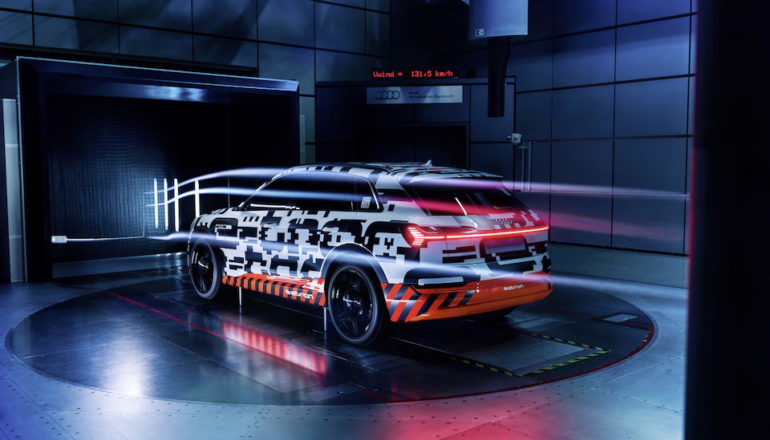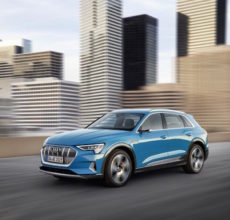We know how important drag or drag co-efficient is for sports cars. So it is for SUVs; and electric SUVs, too. So the Audi e-tron is going 360º to chisel out the best possible aerodynamics and keep the drag coefficient as low as 0.28.
The better an electric car’s aerodynamics, the further it travels: With a drag coefficient of 0.28, the Audi e-tron prototype achieves an everyday range of more than 400 kilometers (248.5 miles) in the WLTP cycle (The worldwide harmonised light vehicle test procedure which assesses fuel efficiency, emissions and all those numbers that matter). While virtual exterior mirrors sound like a cool concept in tech, that too is actually a highlight in the aerodynamics concept of the all-electric SUV.
1000 hours in the wind tunnel
On the aeroacoustics test rig in the Wind Tunnel Center in Ingolstadt, the world’s quietest vehicle wind tunnel, Audi engineers optimize drag and noise under extreme conditions. A low-noise rotor nearly five meters in diameter creates 2.6 megawatts of power, and spins at speeds of up to 300 km/h. Over 1,000 hours of testing here could knock the hulking Q7 into sporting shape! So the result: a drag coefficient of 0.28 for the e-tron. A hundredth of this figure represents a range of around five kilometers under everyday conditions and totals to around 400 km.

Streamline: Audi e-tron prototype with decisive aerodynamics
Every bump and curve in the body counts
On long journeys, the key driving resistance that the Audi e-tron prototype would face is the drag – even more important than the rolling resistance and inertia. The energy required to overcome this resistance is simply lost! Which is why, on long drives, good aerodynamics play a greater role than urban driving, wherein a large part of the used energy can be recovered through braking.
To achieve the drag coefficient of 0.28, the Audi engineers developed a wide range of aerodynamics measures in all body areas, some evident at first glance, while others remain hidden. They keep the drag coefficient for the Audi e-tron prototype almost 0.07 less than that of a comparable, conventionally powered vehicle. With a typical usage profile this set-up increases the range by around 35 kilometers per battery charge in the WLTP cycle.
Smart solutions to keep the drag low: Virtual mirrors and underbody dimples
The optional virtual exterior mirrors will be making their world premiere in the volume-production version of the Audi e-tron prototype. Much narrower than the standard mirrors, they reduce the vehicle width by 15 centimeters, and not only reduce drag but the already low wind noise, too. On either side, the flat support of the mirror integrates a small camera and the captured images can be seen on OLED displays in the transition between the instrument panel and door. The view is adaptable on the MMI system for highway driving, turning and parking.
The standard adaptive air suspension is a pneumatic suspension with adjustable damping. At speeds above 120 km/h, it lowers the body by up to 26 millimeters or one inch below the normal position, thus reducing the drag. The underbody of the all-electric SUV is fully enclosed; the front and rear areas are fully paneled. Underneath the passenger cell, an aluminum plate protects the high-voltage battery against damage from below, such as stone chipping or curbs. Its bolting points come with bowl-shaped indentations, similar to the dimples on a golf ball. They make the air flow much better than a totally flat surface.
The controllable cool-air inlet with two electrically operated louvers also helps lower drag. When shut, the air in this area flows with virtually no swirl but as soon as the drivetrain components need cooling or the air conditioning condenser requires ventilation, or the hydraulic wheel brakes are subject to high loads, the louvers open and channel air to areas in need of cool air.
For a concluding touch on aerodynamics, even the tire sidewalls of the Audi e-tron prototype add to the aerodynamic design – the lettering is negative instead of raised.












